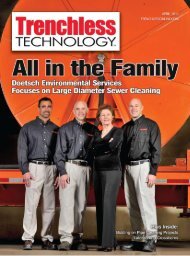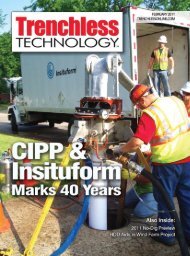Author: Professor, Dr. Dietrich Stein - TrenchlessOnline
Author: Professor, Dr. Dietrich Stein - TrenchlessOnline
Author: Professor, Dr. Dietrich Stein - TrenchlessOnline
Create successful ePaper yourself
Turn your PDF publications into a flip-book with our unique Google optimized e-Paper software.
INTERNATIONAL<br />
hydraulic shoes allow for continuous control of line and<br />
grade, while a laser target system provides instantaneous<br />
measurement of boring accuracy.<br />
SBU Technology & Microtunneling<br />
Many of the crossings on the pipeline are using microtunneling<br />
machines (MTBMs) — 11 crossings utilized MTBMs for<br />
excavation during Phase II of the project, mostly in soft soil<br />
to mixed ground conditions with expected water ingress.<br />
MTBMs are superior in jobs below the water table or in soft<br />
ground; however, they can be highly inefficient in hard rock<br />
conditions.The machines use tungsten carbide drag bits on<br />
the cutting head,which tend to break off in rock above 75 to<br />
100 MPa UCS. The broken bits require expensive replacements,<br />
therefore slowing progress and increasing man-hours.<br />
In dry or near dry conditions, when an auger is used in<br />
conjunction with the MTBM for spoils removal, the microtunneling<br />
method is still more expensive than an SBU<br />
machine with ABM.An MTBM using an auger in this fashion<br />
requires that all rock chipped from the face be further<br />
crushed for removal, resulting in slower excavation rates.<br />
SBU systems, in contrast, use interchangeable single disc<br />
cutters to size the rock chips directly at the face.<br />
While MTBMs are superior in some conditions, they are<br />
much more expensive for hard rock excavation than either<br />
an SBU-A/ABM combination or an SBU-M/ABM setup.<br />
Purchasing a typical MTBM will often cost five to 10 times<br />
more than using an SBU-A, and two to three times as much<br />
as purchasing an SBU-M of the same size.<br />
Advantages of SBU Technology<br />
Williams based his decision to use Robbins SBUs on past<br />
jobsite experience. B&W originally purchased two Robbins<br />
SBU-As in 2002 for a similar natural gas pipeline through siltstone.This<br />
previous project involved six hard rock crossings<br />
along a 70-km pipeline extending from St. Fergus to<br />
Aberdeen in Scotland, United Kingdom.<br />
B&W Tunnelling sees its use of SBUs as a competitive<br />
advantage in the United Kingdom, where the product is not<br />
well known compared to the United States. “These<br />
machines can definitely compete with microtunneling<br />
machines given that they can use concrete pipe and sacrificial<br />
casings. SBUs also do not require slurry — microtunneling<br />
machines are dependent on slurry, which can often be<br />
messy and inefficient,” explained Williams.<br />
Excavating the Crossings<br />
As of summer 2007, SBU excavation has gone extremely<br />
well.Average rates of SBU-M excavation are 1.5 to 2.0 m per<br />
hour and none of the machines have required rebuilding<br />
between crossings.<br />
B&W began excavating the crossings using five Robbins<br />
machines — three 1.2-m diameter SBU-As and two 1.2-m diameter<br />
SBU-Ms.The machines utilize 6.5-,9.5- or 11.5-in.diameter<br />
disc cutters (depending on the rock hardness) to bore<br />
through geology between 70 and 200 MPa UCS. Many of the<br />
crossings are in ground consisting of hard rock interbedded<br />
with clay and gravel, necessitating careful cutterhead design.<br />
Circle 22 on reader service card. Circle 52 on reader service card.<br />
54 TRENCHLESS TECHNOLOGY September 2007 www.trenchlessonline.com








